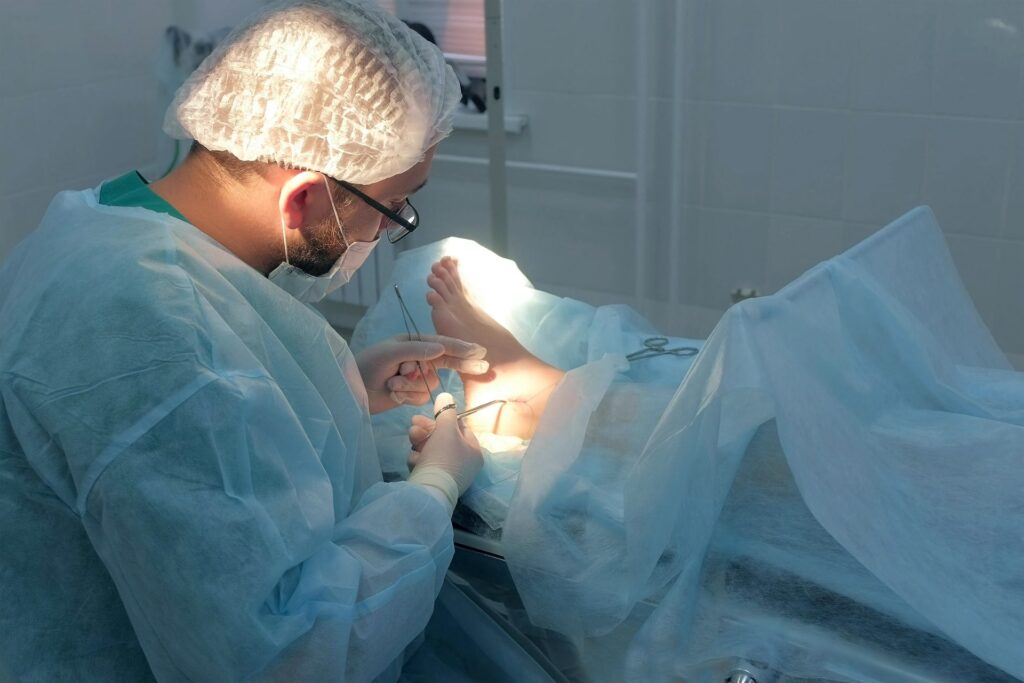Also called the tibiotalar joint or the talocrural joint, the ankle joint is a complex network of ligaments, muscles, cartilage, nerves, and blood vessels that works to stabilize the leg and foot as the ankle joint bends and flexes. Though the ankle is functionally a hinge joint, it’s also a highly-flexible synovial joint leaving it susceptible to many types of injuries thanks to its freedom of movement.
Many ankle injuries can be conservatively treated by a podiatrist or orthopedic foot and ankle specialist (i.e. braces, splints, physical therapy, etc.). More severe ankle injuries, however, may require one of the following common types of ankle surgery.
Ankle Arthroscopy

An ankle arthroscopy is a minimally invasive surgery that is often the next step in treatment when an ankle joint injury doesn’t respond to more conservative treatments (such as physical therapy or steroid injections). During an ankle arthroscopy, the surgeon makes two tiny (typically less than half an inch) incisions in the ankle and inserts an arthroscope – a narrow tool with a light and a camera that provides full visualization of the area. From there, the surgeon can repair the injury arthroscopically or determine if a more invasive form of surgery is necessary.
Though ankle arthroscopy surgery can treat a wide range of injuries and conditions it is commonly used to correct instability, impingement, and torn ligaments or to remove irritating bits of scar tissue, cartilage, or bone.
Brostrom Procedure (Ankle Ligament Surgery)
Also known as a lateral ankle ligament reconstruction, a Brostrom procedure is a common ankle surgery for people who have a history of ankle sprains or certain foot deformities (such as high arches, hindfoot varus, plantar flexion of the first ray, or Ehlers-Danlos). These conditions and/or repeated ankle sprains can lead to chronic ankle instability due to one or more of the ligaments on the outside of the ankle being stretched or loosened over time.
A lateral ankle ligament reconstruction often requires removing the anterior talo-fibular ligament (ATFL) and/or the calcaneofibular ligament (CFL) from the tibia, shortening them, then reattaching the ligament(s) to the bone. While a Brostrom procedure is often performed arthroscopically (see above), a more invasive approach may be necessary to complete the repair.
Achilles Tendon Repair Protocol
Though the Achilles tendon is not technically part of the ankle joint, it plays an important role in overall foot functionality. This is because the Achilles tendon connects the calf muscles (the gastrocnemius and soleus muscles) to the heel bone in the foot and is responsible for helping flex and point the toes and left the heel off the ground. So, while not a part of the ankle joint, the Achilles works in conjunction with the ankle for everyday movements like walking, running, jumping, and climbing stairs.
The Achilles tendons are the largest and strongest tendons in the body and can be affected by numerous conditions and disorders. Many of these conditions can be treated with non-surgical interventions and physical therapy. A torn tendon, however, requires a surgical Achilles tendon repair protocol.
During an Achilles tendon repair, the surgeon will either stitch the tendon back together, remove any damaged tissue then stitch the tendon together, or – in cases of severe damage – replace part or all of the Achilles tendon.
Ankle Replacement Surgery

Commonly used to treat end-stage ankle arthritis – meaning painful, debilitating arthritis of the ankle – ankle replacement surgery can help reduce pain and increase ankle joint mobility and stability. Because total ankle replacement surgery is a significant surgery, this procedure is only recommended when other treatments and surgeries can’t properly address ankle arthritis symptoms or correct a traumatic injury to the ankle.
During an ankle replacement surgery, the surgeon will first remove damaged parts of the tibia (leg) and talus (foot) bones before replacing the damaged ankle joint with an artificial implant.
Ankle Surgery Recovery
Recovery from ankle surgery can vary as widely as each of the procedures discussed above. For instance, you can expect the recovery from an ankle replacement surgery to be much longer and more intensive than a simple ankle arthroscopy. In general, however, there are six steps in most ankle surgery recovery journeys.
- Expect pain, swelling, and limited mobility immediately after surgery.
- Your ankle will be immobilized with a splint, brace, or cast to help protect the incision(s), stabilize the joint, and promote proper healing.
- You will need to be non-weight bearing on the treated ankle for a period of time (time is dependent on the surgery), which will mean using crutches, a walker, or a wheelchair to get around.
- Once you’re cleared for physical therapy, you will work with a physical therapist (PT) to rebuild strength, stability, balance, and a proper gait.
- In time you’ll be cleared by your surgeon and/or PT to gradually start weight-bearing exercises and walking.
- It can take anywhere from several weeks to months, however, you will eventually be able to return to normal activities.
Warning Signs After Ankle Surgery
While most ankle surgeries result in no complications, post-surgery complications do arise on occasion. If you experience any of the following warning signs after ankle surgery, contact your surgeon immediately.
- Excessive pain that does not go away with prescribed medication
- Sudden or significant swelling or redness and/or warmth around the surgical site
- Excessive bleeding or drainage
- Persistent or worsening numbness, tingling, or loss of sensation in your foot or toes
- A fever over 100.4°F
- Worsening or new-onset pain, tenderness, or swelling in the calf
If you have any questions about an ankle injury, treatments, or surgery, please give us a call to discuss your concerns or make an appointment.